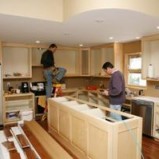
How to Update Your Home, Part 1
Posted on Jan 8, 2014 in Blog, Featured, Home Renovation | 0 comments
As the previous blog mentioned, “updating” your home can be a crucial step in the successful listing and selling of your property. It is not always the determining factor, but as active real estate agents, we’ve seen and heard hundreds of comments about properties that are “outdated” and almost all of them are negative. Occasionally we’ll run across that savvy buyer who can truly overlook old items to see the future possibilities and hidden value, but they are few and far between. Most often, it simply leaves a negative impression on the potential buyer.
So how do you determine what to update and what to leave alone?
Ask! Ask your friends that just sold their home…ask a design professional in a furniture store…ask other real estate professionals that you may know…ask us! But most importantly, ask the network agent we put you in touch with. One of the reasons we’ve included them in our network is their expertise in all facets of real estate including how to stage a home properly. There are several factors that will go into this decision, and we’ll cover them in the next few paragraphs and part 2 of this series.
To see how this all works, let’s look at some basic examples and numbers.
Say you purchased your 2000 sq ft home 5 years ago for $200,000—you paid $100 per sq ft. Now that it is time to sell, one of our network agents will provide you with a market analysis to give you an idea on the current value of your home. You’ll definitively want to pay attention to this, because this is exactly what any potential buyer and their agent will be doing.
A real estate agent’s market analysis will highlight “comps” (short for comparables) for all similar homes that have sold in your area in the past 6-12 months, and this will show the “High”, “Low”, and “Avg” price per sq ft. A home that is in great condition and fully updated will be “comp’d” at the “High” rate, and one that is run down and not updated at all will be at the low rate, and for most us…usually somewhere in between.
Using our example, if the “High” for your area is $105/sq ft, that means at most you’re likely to sell for $210,000—it wouldn’t make any sense to invest $15,000 or $20,000 in upgrades since the market likely won’t support that high of a price. Now let’s say the neighborhood has appreciated nicely and the “High” comparables are $120/sq ft—that would mean a $20,000 upgrade investment might garner a $240,000 selling price, and that would be an solid investment.
Now that you have an idea of how the system works, it is then time for you to determine what items you would like to improve, and how much money you should invest in doing so. Sometimes the best answer, practically and financially, may simply be cosmetic (paint, cleaning, etc…) changes. Other times it may mean anything from swapping out appliances to major remodeling.
Exploring all the different possibilities could fill numerous articles—we’ll do our best to summarize in our next two blogs!



